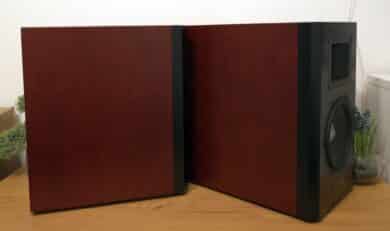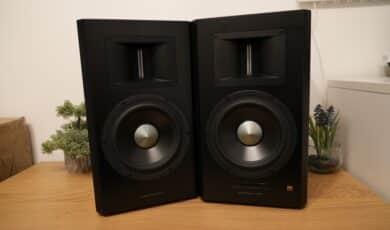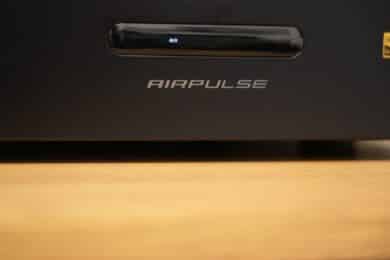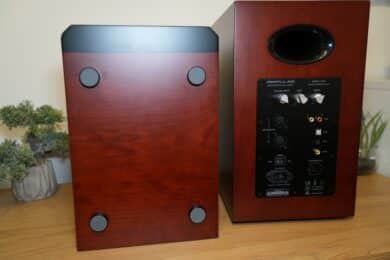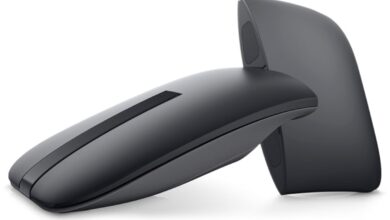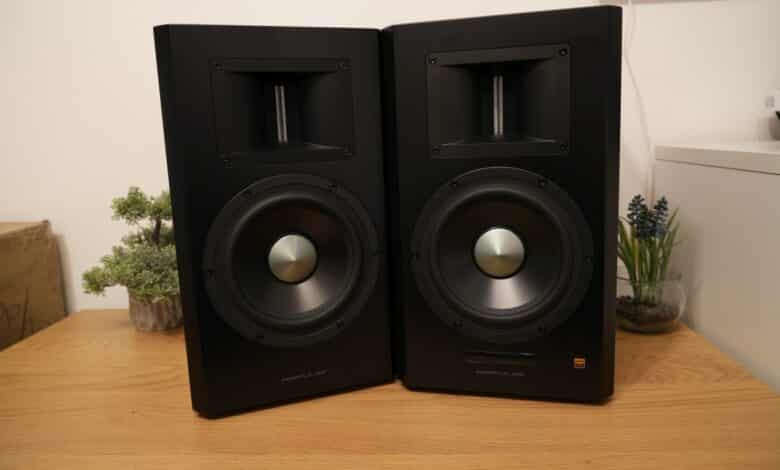
Edifier subsidiary AirPulse presented a whole series of high-quality bookshelf speakers in the middle of last year. After the compact A100 in the test from March 2023 could already inspire us, it is now significantly larger – and not only in terms of dimensions. Our AirPulse A300 test feels the bulky shelf speakers on the tooth.
Technical data
| Product: | AirPulse A300 |
| Dimensions (W x H x D): | 225 mm x 385 mm x 340 mm |
| Weight: | approx. 24 kg |
| Frequency range: | 40 Hz – 40,000 Hz |
| Noise ratio: | > 90 dB(A) |
| Sensitivity: | AUX: 700 ± 50 mV, Balance: 1150 ± 50 mV, USB: 550 ± 50 mFFs, Optical: 500 ± 50 mFFs, Coaxial: 500 ± 50 mFFs Bluetooth: 500 ± 50 mFFs |
| Amplifier: | Digital amplifier with Xmos processor |
| Tweeter: | Horn Loaded Ribbon Tweeter |
| Midrange woofer: | Aluminum tube; 6.5 inches |
| Power: | 2x 10 watts (tweeter); 2x 70 watts (mid-woofer) |
| Connection: | Bluetooth 5.0 (Codec: SBC, aptX), AUX, USB, balance input, optical |
| Price: | € 1,389.00 * |
AirPulse A300 review: design and workmanship
- Large and heavy
- Chic wood-look design
- Impeccable build quality
If AirPulse’s A100s still relied on a black piano lacquer look, the bulky AirPulse A300s in the test come with a retro look that inspires from the first second. In contrast to the S1000W of the Edifier parent (our review), AirPulse relies on a darker wood tone for this model, which thus simultaneously ensures a warmer appearance and cuts an excellent figure in the living room or office.
The 25 mm thick MDF case not only looks very classy, but also leaves an excellent impression in terms of workmanship. The transition between the wooden look, which the A300 inherited from its smaller brother A200, and the black front and back is seamless.
Whereby the technical components at the front and rear are held in place by massive hexagonal screws. No question: With the open design of the mid-woofers, the speakers make a lot of visual impact and also live up to the high price in terms of workmanship.
Visually, the structure of the front section is particularly eye-catching, consisting of horn-loaded ribbon tweeters and 16.5-centimeter-diameter midrange/bass drivers underneath. On the right speaker we also find the IR surface for communication with the remote control including display, as well as a “Hi-Res Audio” imprint.
With a size of 225 x 385 x 340 mm (width x height x depth) and a net weight of 24 kilograms, the speakers are anything but discreet and take up a lot of space accordingly. However, this also has a positive effect on the acoustics, as we will find out later.
Connections, operation and setup
- Convincing selection of connections
- Bluetooth 5.0 with aptX codec
- Impeccable operation with included remote control
In terms of connections, the AirPulse A300 leaves almost nothing to be desired. These are all located on the back of the right speaker, while the two speakers are connected via a separately packed speaker cable.
USB, AUX, balanced inputs, an optical and a coaxial input are available. Alternatively, the A300 can also be played wirelessly via Bluetooth 5.0. The digital inputs allow a resolution of up to 192 kHZ, while the analog inputs come with a high-quality ADC sound pickup.

In order not to have to do without high-resolution sound even when playing wirelessly, the speakers have a Qualcomm chipset that also supports playback in Qualcomm aptX code via a decoder.
The manufacturer includes all potentially required cables, neatly packed individually, in the scope of delivery. We also find a pair of kid gloves to move the A300 without leaving fingerprints on it (even though the body is quite resistant to pressure anyway).
The operation itself is done with the included remote control, which looks confusingly similar to the Edifier S1000W – only with AirPulse imprint. It serves its purpose, but could be a bit more handy.
Otherwise, we find three rotary controls on the back, which we already know in a similar form from other speakers of the manufacturer. With these, we can regulate volume, bass and treble separately. Bass and treble can be increased or decreased by up to 3 dB each.
However, only the volume control has a grid for each intermediate step – the other two controls could have been given this as well. It would also have been nice to be able to adjust bass and treble via the remote control. Thus, we have to turn the massive speakers to get to the back. On the other hand, this fine-tuning is actually only necessary during the initial setup.
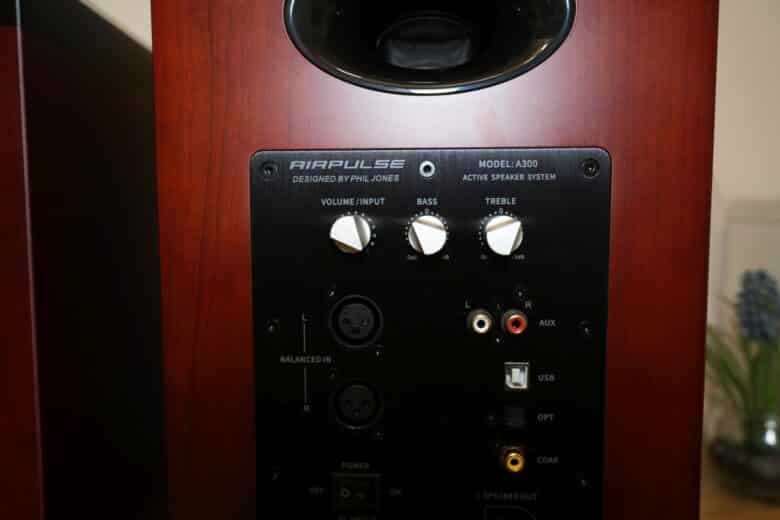
The speakers can be set up in just a few steps. Simply connect both speakers to each other, establish the power supply and you’re ready to go. Bluetooth pairing can be triggered by pressing and holding the corresponding button on the remote control and works in practice both quickly and reliably.
Sound test: Impressive sound in the AirPulse A300
- High-quality tweeters and mid-woofers
- Powerful audio processor and amplifier
- 160 watts of power
Unsurprisingly, the AirPulse A300s also score well from a sound perspective, as the smaller A100s had already performed very well here. Of course, the 300 model also benefits from the additional size, which the shelf and studio speakers convert into an even better sound.
Or, to put it first in terms of specifications, the manufacturer equips the speakers with horn-loaded ribbon tweeters taken directly from its own flagship 7001.
A 65 mm long and 0.12 mm thin aluminum ribbon connects the two large neodymium magnets. Advantage: the ribbon also acts as a diaphragm and is able to move the air, which improves the transient response and thus has a direct impact on the sound.
AirPulse combines this with 6.5-inch aluminum cone mid-bass drivers that boast exceptionally low distortion. A 16-core audio processor, the XMOS XU216, and three TAS5754 Class-D amplifiers from Texas Instrument then skillfully round out the sound picture with low background noise and low distortion.
This results in a total output power of 160 watts, and that’s with a frequency response that, at 40 Hz to 40,000 Hz, reaches deeper into the bass segment than the A100 or Edifier S1000W. And you can actually hear that.
Facetted and detailed sound
- Excellent, detailed sound
- Airy highs, excellent spaciousness
- Digital almost at the same level as analog
Since the smaller siblings of the A300 were already convincing in terms of sound, it comes as little surprise that the larger model also scores here. In fact, the speakers make use of the additional size to realize an even more detailed and lively sound.
The basic setting is surprisingly good, with all three controls in the center position. Here, the A300s reproduce a detailed, spacious sound that shifts the emphasis slightly towards the treble and bass.
The result is a convincing brilliance with – to my taste – minimally over-present bass. However, this has to be seen in a differentiated way, because I’m generally not a big fan of massive basses and always turn them down a bit, if possible.
However, sound preferences are subjective and it is excellent that the manufacturer offers the possibility for fine-tuning here. Personally, I got the best sound for me with -1 treble and -3 bass.
The dynamics of the speakers are impressive, regardless of the setting. Quiet passages are in no way inferior to loud arrangements, while the mids (and thus the instrumentalization as well as the vocals) are reproduced very low in distortion and clear.
In complex arrangements, the speakers impress with an excellent level of detail. In the bridge of “Verdandi” by the Icelandic Viking metal band Skakmöld, for example, the speakers bring the wave noise and even the finest organ sounds to light, which many other speakers like to swallow.
Something similar can be seen in Zeal & Ardor’s complex gospel-black metal mix “Götterdämmerung”, in which the A300 also performs strongly. The atmospheric “Origins” intro by Swiss folk metal band Eluveitie is also pleasing. This achieves an excellent spatiality in which the individual instruments and voices can be precisely located.

I was also pleasantly surprised by how small the differences are between analog and digital, even wireless sound. Via USB (and especially Bluetooth), the AirPulse A300s do not lose any of their dynamic sound, but are a little less precise. So little, however, that the difference should not be noticeable to most listeners.
AirPulse A300 review: conclusion
That Edifier and AirPulse build excellent speakers, we have now already been able to determine several times in the test itself. The AirPulse A300 mark fortunately no exception. Quite the opposite, because those who can find enough space for these admittedly rather bulky speakers will be rewarded with excellent acoustics including Hi-Res sound.
And that across all connection options – whether analog or digital – of which the speakers fortunately also offer quite a few.
In addition, there is the chic design and the impeccable build quality. The AirPulse A300 are undoubtedly not a bargain, but the stereo speakers score with an excellent price-performance ratio, which absolutely justifies the high price by a thoroughly convincing performance.
AirPulse A300
Design & workmanship
Features
Usability
Sound
Value for money
94/100
Enormously high-quality studio speakers that translate their massive size into rich, detailed and precise sound, and delight with excellent connectivity.


